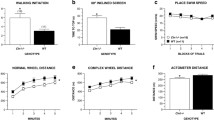Abstract
Tripeptidyl peptidase I (TPPI) — a lysosomal serine protease — is encoded by the CLN2 gene, mutations that cause late-infantile neuronal ceroid lipofuscinosis (LINCL) connected with profound neuronal loss, severe clinical symptoms and early death at puberty. Developmental studies of TPPI activity levels and distribution have been done in the human and rat central nervous systems (CNS) and visceral organs. Similar studies have not been performed in mouse. In this paper, we follow up on the developmental changes in the enzyme activity and localization pattern in the CNS and visceral organs of mouse over the main periods of life — embryonic, neonate, suckling, infantile, juvenile, adult and aged — using biochemical assays and enzyme histochemistry. In the studied peripheral organs (liver, kidney, spleen, pancreas and lung) TPPI is present at birth but further its pattern is not consistent in different organs over different life periods. TPPI activity starts to be expressed in the brain at the 10th embryonic day but in most neuronal types it appears at the early infantile period, increases during infancy, reaches high activity levels in the juvenile period and is highest in adult and aged animals. Thus, in mice TPPI activity becomes crucial for the neuronal functions later in development (juvenile period) than in humans and does not decrease with aging. These results are essential as a basis for comparison between normal and pathological TPPI patterns in mice. They can be valuable in view of the use of animal models for studying LINCL and other neurodegenerative disorders.




Similar content being viewed by others
References
Bernardini F, Warburton M (2002) Lysosomal degradation of cholecystokinin-(29–33)-amide in mouse brain is dependent of tripeptidyl peptidase - I:implications for the degradation and storage of peptides in classical late-infantile neuronal ceroid lipofuscinosis. Biochem J 366:521–529
Dawson R, Elliot D, Elliot W, Jones K (1991) Biochemists manual (in Russian). Mir, Moscow, p 301
Dikov A, Dimitrova M, Ivanov I, Krieg R, Halbhuber K-J (2000) Original method for histochemical demonstration of tripeptidyl aminopeptidase I. Cell Mol Biol 46:1219–1225
Dimitrova M, Deleva D (2009) Histochemical study of the changes in trypeptidyl peptidase I activity in developing rat brain and spinal cord. Compt Rend Acad Bulg Sci 62:1407–1412
Dimitrova M, Ivanov I, Todorova R, Tsenova V (2008) Fluorescent localization of tripeptidyl peptidase I activity in tissue sections of Balb/c mice reproductive organs. Compt Rend Acad Bulg Sci 61:349–356
Du P, Kato S, Li Y, Maeda T, Yamane T, Yamamoto S, Fujiwara M, Yamamoto Y, Nishi K, Ohkubo I (2001) Rat tripeptidyl peptidase I: molecular cloning, functional expression, tissue localization and enzymatic characterization. Biol Chem 382:1715–1725
Glees P, Hasan M (1976) Lipofuscin in neuronal aging and diseases. Thieme, Stuttgart, pp 1–68
Kida E, Golabeki A, Walus M, Wujek P, Kaczmarski W, Wisniewski K (2001) Distribution of trypeptidyl peptidase I in human tissues under normal and pathological conditions. J Neuropathol Exper Neurol 60:280–292
Koike M, Shibata M, Ohsawa Y, Kametaka S, Waguri S, Kominami E, Uchiyama Y (2002) The expression of trypeptidyl peptidase I in various tissues of rats and mice. Arch Histol Cytol 65:219–232
Kurachi Y, Oka A, Itoh M, Mizuguchi M, Hayashi M, Takashima S (2001) Distribution and development of CLN2 protein, the late-infantile neuronal ceroid lipofuscinosis gene product. Acta Neuropathol 102:20–26
Mole S, Williams E, Goebel H (2005) Correlation between genotype, ultrastructural morphology and clinical phenotype in the neuronal ceroid lipofuscinoses. Neurogenetics 6:107–126
Oka A, Kurachi Y, Mizuguchi M, Hayashi M, Takashima S (1998) The expression of late infantile neuronal ceroid lipofuscinosis (CLN2) gene product in human brains. Neurosci Lett 257:113–115
Page AE, Fuller K, Chambers TJ, Warburton MJ (1993) Purification and characterization of a tripeptidyl peptidase I from human osteoclastomas: Evidence for its role in bone resorption. Arch Biochem Biophys 306:354–359
Sleat D, Donnelly R, Lackland H, Liu C-G, Sohar I, Pullarkat R, Lobel P (1997) Association of mutations in a lysosomal protein with classical late-infantile neuronal ceroid lipofuscinosis. Science 277:1802–1805
Sleat D, Wiseman J, El-Banna M, Kim K-H, Mao Q, Price S, Macauley S, Sidman R, Shen M, Zhao Q, Passini M, Davidson B, Stewart G, Lobel P (2004) A mouse model of classical late-infantile neuronal ceroid lipofuscinosis based on targeted disruption of the CLN2 gene results in a loss of trypeptidyl peptidase I activity and progressive neurodegeneration. J Neurosci 24:9117–9126
Suopanki J, Partanen S, Ezaki J, Baumann M, Kominami E, Tyynela J (2000) Developmental changes in the expression of neuronal ceroid lipofuscinoses-linked proteins. Mol Genet Metab 71:190–194
Vines D, Warburton MJ (1998) Purification and characterisation of a tripeptidyl aminopeptidase I from rat spleen. Biochim Biophys Acta 1384:233–242
Williams R, Gottlob I, Lake B, Goebel H, Winchester B, Wheeler R (1999) CLN2. Classic late infantile NCL. In: Goebel H, Mole S, Lake B (eds) The neuronal ceroid lipofuscinoses (Batten disease). IOS Press, Amsterdam, pp 37–54
Zapadnjuk V, Zapadnjuk I, Zacharija E (1974) The laboratory animals (in Russian).Vishta Shkola Publishing House, Kiev, pp 23–24
Author information
Authors and Affiliations
Corresponding author
Electronic supplementary material
Below is the link to the electronic supplementary material.
Fig. S1
Grading of TPPI activity levels on the example of Purkinje cells. Low enzyme activity at 22 PD is graded with one plus (+) (a). Substantial TPPI activity at 33 PD graded with two pluses (++) (b). High enzyme activity at 49 PD – (+++) (c). Bars 25 μm (JPEG 311 kb)
Rights and permissions
About this article
Cite this article
Dimitrova, M., Deleva, D., Pavlova, V. et al. Developmental study of tripeptidyl peptidase I activity in the mouse central nervous system and peripheral organs. Cell Tissue Res 346, 141–149 (2011). https://doi.org/10.1007/s00441-011-1252-0
Received:
Accepted:
Published:
Issue Date:
DOI: https://doi.org/10.1007/s00441-011-1252-0




